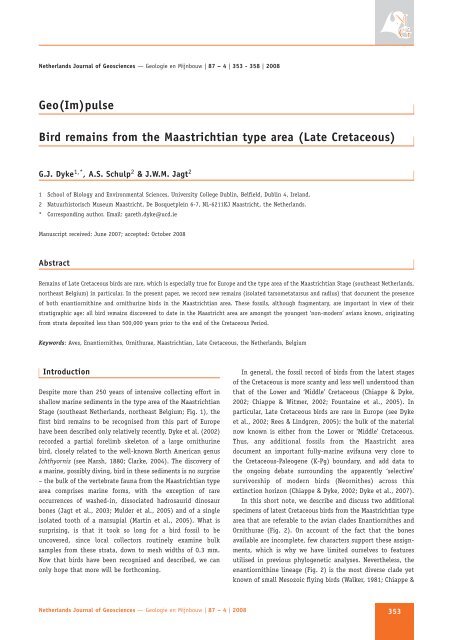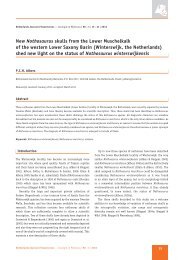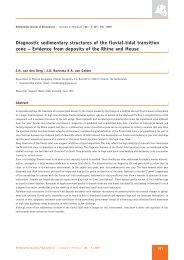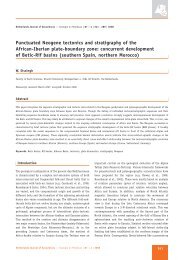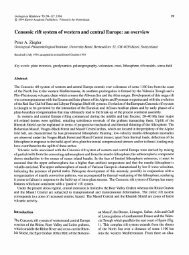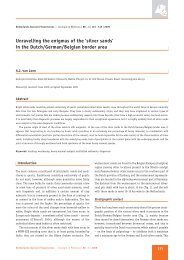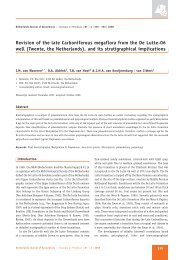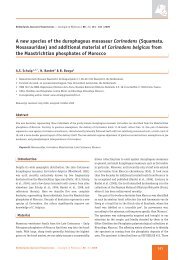Geo(Im)pulse Bird remains from the Maastrichtian type area (Late ...
Geo(Im)pulse Bird remains from the Maastrichtian type area (Late ...
Geo(Im)pulse Bird remains from the Maastrichtian type area (Late ...
Create successful ePaper yourself
Turn your PDF publications into a flip-book with our unique Google optimized e-Paper software.
Ne<strong>the</strong>rlands Journal of <strong>Geo</strong>sciences — <strong>Geo</strong>logie en Mijnbouw | 87 – 4 | 353 - 358 | 2008<br />
<strong>Geo</strong>(<strong>Im</strong>)<strong>pulse</strong><br />
<strong>Bird</strong> <strong>remains</strong> <strong>from</strong> <strong>the</strong> <strong>Maastrichtian</strong> <strong>type</strong> <strong>area</strong> (<strong>Late</strong> Cretaceous)<br />
G.J. Dyke 1,* , A.S. Schulp 2 & J.W.M. Jagt 2<br />
1 School of Biology and Environmental Sciences, University College Dublin, Belfield, Dublin 4, Ireland.<br />
2 Natuurhistorisch Museum Maastricht, De Bosquetplein 6-7, NL-6211KJ Maastricht, <strong>the</strong> Ne<strong>the</strong>rlands.<br />
* Corresponding author. Email: gareth.dyke@ucd.ie<br />
Manuscript received: June 2007; accepted: October 2008<br />
Abstract<br />
Remains of <strong>Late</strong> Cretaceous birds are rare, which is especially true for Europe and <strong>the</strong> <strong>type</strong> <strong>area</strong> of <strong>the</strong> <strong>Maastrichtian</strong> Stage (sou<strong>the</strong>ast Ne<strong>the</strong>rlands,<br />
nor<strong>the</strong>ast Belgium) in particular. In <strong>the</strong> present paper, we record new <strong>remains</strong> (isolated tarsometatarsus and radius) that document <strong>the</strong> presence<br />
of both enantiornithine and ornithurine birds in <strong>the</strong> <strong>Maastrichtian</strong> <strong>area</strong>. These fossils, although fragmentary, are important in view of <strong>the</strong>ir<br />
stratigraphic age: all bird <strong>remains</strong> discovered to date in <strong>the</strong> Maastricht <strong>area</strong> are amongst <strong>the</strong> youngest ‘non-modern’ avians known, originating<br />
<strong>from</strong> strata deposited less than 500,000 years prior to <strong>the</strong> end of <strong>the</strong> Cretaceous Period.<br />
Keywords: Aves, Enantiorni<strong>the</strong>s, Ornithurae, <strong>Maastrichtian</strong>, <strong>Late</strong> Cretaceous, <strong>the</strong> Ne<strong>the</strong>rlands, Belgium<br />
Introduction<br />
Despite more than 250 years of intensive collecting effort in<br />
shallow marine sediments in <strong>the</strong> <strong>type</strong> <strong>area</strong> of <strong>the</strong> <strong>Maastrichtian</strong><br />
Stage (sou<strong>the</strong>ast Ne<strong>the</strong>rlands, nor<strong>the</strong>ast Belgium; Fig. 1), <strong>the</strong><br />
first bird <strong>remains</strong> to be recognised <strong>from</strong> this part of Europe<br />
have been described only relatively recently. Dyke et al. (2002)<br />
recorded a partial forelimb skeleton of a large ornithurine<br />
bird, closely related to <strong>the</strong> well-known North American genus<br />
Ichthyornis (see Marsh, 1880; Clarke, 2004). The discovery of<br />
a marine, possibly diving, bird in <strong>the</strong>se sediments is no surprise<br />
– <strong>the</strong> bulk of <strong>the</strong> vertebrate fauna <strong>from</strong> <strong>the</strong> <strong>Maastrichtian</strong> <strong>type</strong><br />
<strong>area</strong> comprises marine forms, with <strong>the</strong> exception of rare<br />
occurrences of washed-in, dissociated hadrosaurid dinosaur<br />
bones (Jagt et al., 2003; Mulder et al., 2005) and of a single<br />
isolated tooth of a marsupial (Martin et al., 2005). What is<br />
surprising, is that it took so long for a bird fossil to be<br />
uncovered, since local collectors routinely examine bulk<br />
samples <strong>from</strong> <strong>the</strong>se strata, down to mesh widths of 0.3 mm.<br />
Now that birds have been recognised and described, we can<br />
only hope that more will be forthcoming.<br />
Ne<strong>the</strong>rlands Journal of <strong>Geo</strong>sciences — <strong>Geo</strong>logie en Mijnbouw | 87 – 4 | 2008<br />
In general, <strong>the</strong> fossil record of birds <strong>from</strong> <strong>the</strong> latest stages<br />
of <strong>the</strong> Cretaceous is more scanty and less well understood than<br />
that of <strong>the</strong> Lower and ‘Middle’ Cretaceous (Chiappe & Dyke,<br />
2002; Chiappe & Witmer, 2002; Fountaine et al., 2005). In<br />
particular, <strong>Late</strong> Cretaceous birds are rare in Europe (see Dyke<br />
et al., 2002; Rees & Lindgren, 2005): <strong>the</strong> bulk of <strong>the</strong> material<br />
now known is ei<strong>the</strong>r <strong>from</strong> <strong>the</strong> Lower or ‘Middle’ Cretaceous.<br />
Thus, any additional fossils <strong>from</strong> <strong>the</strong> Maastricht <strong>area</strong><br />
document an important fully-marine avifauna very close to<br />
<strong>the</strong> Cretaceous-Paleogene (K-Pg) boundary, and add data to<br />
<strong>the</strong> ongoing debate surrounding <strong>the</strong> apparently ‘selective’<br />
survivorship of modern birds (Neorni<strong>the</strong>s) across this<br />
extinction horizon (Chiappe & Dyke, 2002; Dyke et al., 2007).<br />
In this short note, we describe and discuss two additional<br />
specimens of latest Cretaceous birds <strong>from</strong> <strong>the</strong> <strong>Maastrichtian</strong> <strong>type</strong><br />
<strong>area</strong> that are referable to <strong>the</strong> avian clades Enantiorni<strong>the</strong>s and<br />
Ornithurae (Fig. 2). On account of <strong>the</strong> fact that <strong>the</strong> bones<br />
available are incomplete, few characters support <strong>the</strong>se assignments,<br />
which is why we have limited ourselves to features<br />
utilised in previous phylogenetic analyses. Never<strong>the</strong>less, <strong>the</strong><br />
enantiornithine lineage (Fig. 2) is <strong>the</strong> most diverse clade yet<br />
known of small Mesozoic flying birds (Walker, 1981; Chiappe &<br />
353
N<br />
Geulhem Valkenburg<br />
Vroenhoven-<br />
Blom / Berg en Terblijt<br />
Riemst<br />
ENCI-Maastricht B.V.<br />
Zichen-Zussen-Bolder<br />
CBR-Romontbos<br />
Marnebel<br />
Maastricht<br />
Ankerpoort-'t Rooth<br />
354<br />
Curfs<br />
BELGIUM<br />
GERMANY<br />
0 10km<br />
a. b.<br />
MAASTRICHTIAN<br />
Stage<br />
Formation<br />
MAASTRICHT FORMATION<br />
Member<br />
Meerssen<br />
Member<br />
Nekum<br />
Member<br />
Emael<br />
Member<br />
Schiepersberg M.<br />
Gronsveld<br />
Member<br />
Valkenburg M.<br />
Lithology<br />
Fig. 1. a. Map of <strong>the</strong> <strong>type</strong> <strong>area</strong> of <strong>the</strong> <strong>Maastrichtian</strong> Stage; and b. local lithostratigraphy and generalised log (for more details, see Schiøler et al., 1997;<br />
Jagt, 1999). Indicated in A are key sections, those having yielding bird <strong>remains</strong> are bold and italicised; numbered arrows in B show <strong>the</strong> stratigraphic<br />
provenance of bird <strong>remains</strong> known to date <strong>from</strong> <strong>the</strong> <strong>area</strong>, as follows: 1 = NHMM RD 271; 2 = NHMM K 4101; 3 = NHMM K 4925.<br />
Early<br />
JURASSIC<br />
Middle<br />
MESOZOIC CENOZOIC<br />
<strong>Late</strong><br />
Early<br />
CRETACEOUS<br />
<strong>Late</strong><br />
205 176 159 144 99 65 Ma<br />
Aves<br />
Pygostylia<br />
Ornithothoraces<br />
Confuciusornithidae<br />
Ornithuromorpha<br />
Euenantiorni<strong>the</strong>s<br />
Ornithurae<br />
Enantiorni<strong>the</strong>s<br />
Fig. 2. Cladogram of Mesozoic birds (modified <strong>from</strong> Chiappe & Dyke, 2002).<br />
PALEOGENE<br />
Paleocene<br />
Archaeopteryx<br />
Rahonavis<br />
Jeholornis<br />
Changchengornis<br />
Confuciusornis<br />
Cathayornis<br />
Gobipteryx<br />
Neuquenornis<br />
Concornis<br />
Eoalulavis<br />
Iberomesornis<br />
Protopteryx<br />
Patagopteryx<br />
Vorona<br />
Apsaravis<br />
Ne<strong>the</strong>rlands Journal of <strong>Geo</strong>sciences — <strong>Geo</strong>logie en Mijnbouw | 87 – 4 | 2008<br />
10 m<br />
Hesperornithiformes<br />
Ichthyornis<br />
Modern<br />
birds<br />
3<br />
2<br />
1
Walker, 2002), while <strong>the</strong> Ornithurae includes a number of o<strong>the</strong>r<br />
well-known, short-tailed birds, particularly well represented in<br />
<strong>the</strong> Cretaceous of Asia (China, Mongolia) and North America<br />
(Chiappe & Dyke, 2002). The sister taxa of <strong>the</strong> Neorni<strong>the</strong>s are<br />
contained within <strong>the</strong> Ornithurae, and are represented in <strong>the</strong><br />
<strong>Maastrichtian</strong> <strong>type</strong> <strong>area</strong> (Dyke et al., 2002). All material is<br />
housed at <strong>the</strong> Natuurhistorisch Museum Maastricht (abbreviation<br />
NHMM; prefixes RD – R.W. Dortangs Collection; K – M.M.M.<br />
Kuypers Collection).<br />
Material<br />
To date, three fragmentary bird specimens are known <strong>from</strong> <strong>the</strong><br />
<strong>Maastrichtian</strong> <strong>type</strong> <strong>area</strong>, as follows:<br />
1. a partial forelimb and skull bones (NHMM RD 271) <strong>from</strong> <strong>the</strong><br />
base of <strong>the</strong> Valkenburg Member (Maastricht Formation) at<br />
<strong>the</strong> CBR-Romontbos quarry (Eben Emael, Liège, nor<strong>the</strong>ast<br />
Belgium), previously described and illustrated by Dyke et al.<br />
(2002);<br />
2. an isolated left tarsometatarsus (NHMM K 4925) <strong>from</strong> <strong>the</strong><br />
middle Emael Member (Lava Horizon; Maastricht Formation)<br />
at <strong>the</strong> CBR-Romontbos quarry (Eben Emael);<br />
3. <strong>the</strong> proximal end of a left radius (NHMM K 4101) <strong>from</strong> <strong>the</strong><br />
basal Emael Member (Maastricht Formation) at <strong>the</strong> Marnebel<br />
quarry (Eben Emael).<br />
Systematic palaeontology<br />
Aves Linnaeus, 1758<br />
Ornithothoraces Chiappe, 1995<br />
Ornithurae Haeckel, 1866<br />
A full description of NHMM RD 271 was provided by Dyke et al.<br />
(2002). This partial forelimb skeleton comprises an incomplete<br />
right humerus (embedded obliquely such that its cranial surface<br />
is visible), <strong>the</strong> distal end of a right ulna, a scapula blade, as<br />
well as portions of <strong>the</strong> proximal tarsometatarsus and mandible<br />
(Fig. 3A). Originally embedded in <strong>the</strong> same matrix block, but<br />
removed during preparation, are <strong>the</strong> cranial portion of a right<br />
coracoid, three isolated thoracic vertebrae and a single, recurved<br />
and unserrated tooth (Dyke et al., 2002, fig. 1b-d). Salient<br />
features of <strong>the</strong> anatomy of this ornithurine bird include a<br />
rounded, globose head and well-developed deltopectoral crest<br />
of <strong>the</strong> humerus (this crest appears to have extended quite along<br />
<strong>the</strong> length of <strong>the</strong> humerus), proximal and distal ends that are<br />
not offset <strong>from</strong> one ano<strong>the</strong>r (Fig. 3A) and a well-developed<br />
brachial fossa on <strong>the</strong> distal humerus. These features support<br />
placement of NHMM RD 271 close to <strong>the</strong> crown of <strong>the</strong> cladogram<br />
(Fig. 2). O<strong>the</strong>r skeletal elements associated in <strong>the</strong> matrix block<br />
with <strong>the</strong> humerus include <strong>the</strong> distal end of <strong>the</strong> right ulna<br />
(offset somewhat <strong>from</strong> its original articulation), part of <strong>the</strong><br />
blade of <strong>the</strong> scapula and <strong>the</strong> shoulder end of <strong>the</strong> right coracoid.<br />
What <strong>remains</strong> of <strong>the</strong> ulna is rounded in cross section; <strong>the</strong> scapula<br />
Ne<strong>the</strong>rlands Journal of <strong>Geo</strong>sciences — <strong>Geo</strong>logie en Mijnbouw | 87 – 4 | 2008<br />
of this bird was distinctly recurved and sagitally tapered as in<br />
o<strong>the</strong>r ornithurines. The length of this element relative to <strong>the</strong><br />
humerus cannot be determined. As appears to be typical of nonneornithine<br />
Mesozoic birds, <strong>the</strong> preserved postcranial skeleton<br />
of NHMM RD 271 is not particularly pneumatised, with <strong>the</strong><br />
exception of <strong>the</strong> vertebral series. The three quite well-preserved<br />
mid-series thoracic vertebrae that are part of this specimen have<br />
elongate centra perforated on <strong>the</strong>ir lateral sides by distinct and<br />
large foramina (Dyke et al., 2002, fig. 1b, c). Few o<strong>the</strong>r features<br />
of phylogenetic interest can be identified. Portions of <strong>the</strong> left<br />
and right mandibular rami are embedded obliquely in <strong>the</strong> slab,<br />
while <strong>the</strong> preserved dentary appears to be broad and tapers into<br />
articulation with an elongate angular (Dyke et al. 2002).<br />
The partial left tarsometatarsus (NHMM K 4925) (Fig. 3B, C)<br />
is broken proximally with respect to its three discernible<br />
trochlea. The second and fourth digits of this specimen are<br />
broken distally such that <strong>the</strong>ir trochlea are not preserved; <strong>the</strong><br />
distal margin of <strong>the</strong> distal vascular foramen is not preserved<br />
ei<strong>the</strong>r, but its proximal groove is still present. Despite its<br />
fragmentary nature, this element displays a number of features<br />
that in <strong>the</strong> literature have been considered phylogenetically<br />
informative with respect to basal avians, i.e. <strong>the</strong> presence of a<br />
distinct, single distal vascular foramen and a distally extensive<br />
and plantarly displaced third metatarsal (with respect to its<br />
preserved counterparts; Fig. 3B, C). Metatarsals II-IV are completely<br />
fused and although not completely preserved, it is clear<br />
that <strong>the</strong> distal vascular foramen was enclosed by <strong>the</strong> third and<br />
fourth metatarsals in this specimen. These are characteristic<br />
features of ornithuromorph birds (Fig. 2; see Chiappe, 2002).<br />
In addition, <strong>the</strong> medial margin of <strong>the</strong> third trochlea is indented<br />
such that its lateral and medial edges are offset, while its lateral<br />
margin extends somewhat fur<strong>the</strong>r distally. Of <strong>the</strong>se features,<br />
one (i.e., plantar displacement of <strong>the</strong> third metatarsal) is seen,<br />
for example, in <strong>the</strong> genera Yanornis and Apsaravis as well as<br />
in more derived ornithurines. Plantar displacement of<br />
metatarsal III is also consistent with <strong>the</strong> ornithurine<br />
assignment of this element (see Clarke, 2004). Thus, <strong>the</strong> overall<br />
shape of this tarsometatarsus complies with its placement<br />
within Ornithurae, although it is much smaller than its<br />
counterpart in NHMM RD 271 (Dyke et al., 2002) and narrower<br />
than that of North American Ichthyornis.<br />
The proximal left radius (NHMM K 4101), seen in dorsal view<br />
(Fig. 3D, E), is a robust bone that is broken distally at about<br />
one-third of its approximate total length. Cracking of this<br />
element distorts <strong>the</strong> distal dorsal surface, but <strong>the</strong> humeral cotyla<br />
and articulation faces for <strong>the</strong> ulnaris are clearly visible. On its<br />
ventral surface, <strong>the</strong> shaft of this element bears a distinct longitudinal<br />
groove – a characteristic feature seen in a number of<br />
euenantiornithines (Chiappe & Walker, 2002). In addition to<br />
this ventral groove, a pair of small bicipital tubercles are also<br />
present close to <strong>the</strong> proximal articulating surface, one above <strong>the</strong><br />
o<strong>the</strong>r; <strong>the</strong> presence of such tubercles has also been considered<br />
characteristic of Enantiorni<strong>the</strong>s (Chiappe & Walker, 2002).<br />
355
Discussion<br />
Phylogenetic position of birds <strong>from</strong><br />
<strong>the</strong> <strong>Maastrichtian</strong> <strong>type</strong> <strong>area</strong><br />
Although only a small sample is currently available, <strong>the</strong> material<br />
previously recorded by Dyke et al. (2002) and described herein<br />
shows that a reasonably diverse <strong>Late</strong> Cretaceous avifauna was<br />
present in <strong>the</strong> <strong>area</strong>. Because <strong>the</strong> fossil record of Mesozoic avians<br />
356<br />
<strong>from</strong> marine and marginal marine settings is much more complete<br />
than that <strong>from</strong> terrestrial sediments (Fountaine et al.,<br />
2005), we envisage <strong>the</strong> recovery of much more bird material<br />
<strong>from</strong> this <strong>area</strong> in future. On <strong>the</strong> basis of what is available now,<br />
strong evidence for <strong>the</strong> presence of both ornithurines (NHMM<br />
RD 271, NHMM K 4925) and enantiornithines (NHMM K 4101) is<br />
given. There are few o<strong>the</strong>r localities exposing Upper Cretaceous<br />
strata that preserve representatives of both clades so close to<br />
<strong>the</strong> K-Pg boundary.<br />
Fig. 3. Avian <strong>remains</strong> <strong>from</strong> <strong>the</strong> <strong>Maastrichtian</strong> <strong>type</strong> <strong>area</strong>; A – NHMM RD 271, base of Valkenburg Member, CBR-Romontbos quarry, Eben Emael (see Dyke<br />
et al., 2002); B, C – NHMM K 4925, middle Emael Member, CBR-Romontbos quarry, Eben Emael; tarsometatarsus, in cranial and caudal views, respectively;<br />
D, E – NHMM K 4101, base of Emael Member, Marnebel quarry, Eben Emael; proximal left radius. Scale bar equals 10 mm.<br />
Ne<strong>the</strong>rlands Journal of <strong>Geo</strong>sciences — <strong>Geo</strong>logie en Mijnbouw | 87 – 4 | 2008
The phylogenetic placement of NHMM RD 271 was assessed<br />
by Dyke et al. (2002, p. 408), who, on <strong>the</strong> basis of a limited<br />
set of characters, noted that it should be considered ‘closely<br />
related’ to Ichthyornis. Never<strong>the</strong>less, NHMM RD 271 and <strong>the</strong><br />
North American Ichthyornis do differ anatomically as well as<br />
in size. In spite of its age and potential informativeness,<br />
NHMM RD 271 was not included by Clarke (2004) in a more<br />
complete anatomical matrix of Aves. Clarke (2004, pp. 14)<br />
justified this omission by casting aspersions about <strong>the</strong> accuracy<br />
of <strong>the</strong> description presented by Dyke et al. (2002) – ‘if <strong>the</strong><br />
description is faithful to <strong>the</strong> specimen’ (Clarke, 2004: p. 14)<br />
and ‘so far as <strong>the</strong>ir meaning (characters) was understood’<br />
(Clarke, 2004: p. 15).<br />
However, because NHMM RD 271 is incomplete, and its<br />
preserved morphology fragmentary, little additional information<br />
can usefully be presented that bears on <strong>the</strong> relationship of<br />
this bird to o<strong>the</strong>r ornithurines. We have coded <strong>the</strong> preserved<br />
anatomy of this specimen into more recently published phylogenetic<br />
analyses of basal birds (Chiappe, 2002; Clarke, 2004;<br />
Clarke et al., 2006) and its placement relative to <strong>the</strong> avian<br />
crown-group (Neorni<strong>the</strong>s) still <strong>remains</strong> unresolved – within a<br />
polytomy alongside Ichthyornis and Neorni<strong>the</strong>s (see Dyke et<br />
al., 2002, fig. 1e). The recovery of additional material of this<br />
ornithurine taxon <strong>from</strong> <strong>the</strong> Maastricht <strong>area</strong> is required to<br />
resolve <strong>the</strong> issue of its phylogenetic relationships.<br />
Postcranial pneumaticity in Mesozoic birds<br />
In common with o<strong>the</strong>r ‘non-neornithine’ fossil birds, NHMM<br />
RD 271 (along with <strong>the</strong> o<strong>the</strong>r elements known <strong>from</strong> <strong>the</strong><br />
<strong>Maastrichtian</strong> <strong>type</strong> <strong>area</strong>) are relatively less pneumatised that<br />
<strong>the</strong>ir counterpart bones amongst basal modern birds. The<br />
humeri, and o<strong>the</strong>r appendicular bones, of palaeognaths<br />
(Tinamidae) as well as those of Anseriformes (‘waterbirds’) and<br />
Galliformes (‘landfowl’) are typically perforated by foramina<br />
that vary in size (O’Connor, 2004). This reflects perforation of<br />
<strong>the</strong> modern avian axial and appendicular skeleton by air-sacs,<br />
a feature considered unique to birds amongst archosaurs<br />
(O’Connor, 2006). Perforation of <strong>the</strong> appendicular skeleton by<br />
pneumatic foramina is much less common in basal Cretaceous<br />
birds, rarely reported in enantiornithines (Chiappe et al.,<br />
2006) and <strong>the</strong>ir counterparts, <strong>the</strong> more phylogenetically<br />
crownward ornithurines (Zhou & Zhang, 2006), except as<br />
characters for cladistic analysis (Clarke et al., 2006).<br />
Enantiornithines and ornithurines (such as NHMM RD 271)<br />
typically have well-developed foramina associated with <strong>the</strong>ir<br />
vertebrae, but much less so in <strong>the</strong> bones of <strong>the</strong> appendicular<br />
skeleton. If avian cladograms could be shown to be timecorrelated<br />
– in terms of <strong>the</strong> appearance of clade divergences –<br />
<strong>the</strong>n increasing pneumatisation of <strong>the</strong> postcranial skeleton<br />
may turn out to be a feature associated with <strong>the</strong> modern avian<br />
radiation across <strong>the</strong> K-Pg boundary.<br />
Ne<strong>the</strong>rlands Journal of <strong>Geo</strong>sciences — <strong>Geo</strong>logie en Mijnbouw | 87 – 4 | 2008<br />
Acknowledgements<br />
Our thanks are extended to Rudi Dortangs (Amstenrade) and<br />
Marcel Kuypers (Bremen), who collected and recognised<br />
<strong>the</strong> material described here, and to <strong>the</strong> managements of <strong>the</strong><br />
CBR-Romontbos, Marnebel, Ankerpoort - ’t Rooth and ENCI-<br />
HeidelbergCement Group quarries, who allowed access to <strong>the</strong>ir<br />
grounds, which is gratefully acknowledged.<br />
References<br />
Chiappe, L.M., 1995. The first 85 million years of avian evolution. Nature 378:<br />
349-355.<br />
Chiappe, L.M., 2002. Basal bird phylogeny. Problems and solutions. In: Chiappe,<br />
L.M. & Witmer, L.M. (eds): Mesozoic birds. Above <strong>the</strong> heads of dinosaurs.<br />
University of California Press (Berkeley): 448-472.<br />
Chiappe, L.M. & Dyke, G.J., 2002. The Mesozoic radiation of birds. Annual<br />
Reviews of Ecology and Systematics 33: 91-124.<br />
Chiappe, L.M. & Walker, C.A., 2002. Skeletal morphology and systematics of <strong>the</strong><br />
Cretaceous Euenantiorni<strong>the</strong>s (Ornithothoraces: Enantiorni<strong>the</strong>s). In: Chiappe,<br />
L.M. & Witmer, L.M. (eds): Mesozoic birds. Above <strong>the</strong> heads of dinosaurs.<br />
University of California Press (Berkeley): 240-267.<br />
Chiappe, L.M. & Witmer, L.M., 2002 (eds). Mesozoic birds. Above <strong>the</strong> heads of<br />
dinosaurs. University of California Press (Berkeley): xii + 520 pp.<br />
Chiappe, L.M. Suzuki, S., Dyke, G.J., Watabe, M., Tsogtbaatar & Barsbold, R.,<br />
2006. A new enantiornithine bird <strong>from</strong> <strong>the</strong> <strong>Late</strong> Cretaceous of <strong>the</strong> Gobi<br />
Desert. Journal of Systematic Palaeontology 4(4): 1-16.<br />
Clarke, J.A., 2004. Morphology, phylogenetic taxonomy, and systematics of<br />
Ichthyornis and Apatornis (Avialae: Ornithurae). Bulletin of <strong>the</strong> American<br />
Museum of Natural History 286: 1-179.<br />
Clarke, J.A., Zhou, Z. & Zhang, F., 2006. Insight into <strong>the</strong> evolution of avian<br />
flight <strong>from</strong> a new clade of Early Cretaceous ornithurines <strong>from</strong> China and <strong>the</strong><br />
morphology of Yixianornis grabaui. Journal of Anatomy 208(3): 287-308.<br />
Dyke, G.J., Dortangs, R.W., Jagt, J.W.M., Mulder, E.W.A., Schulp, A.S. &<br />
Chiappe, L.M., 2002. Europe’s last Mesozoic bird. Naturwissenschaften 89:<br />
408-411.<br />
Fountaine, T.M.R., Benton, M.J., Dyke, G.J. & Nudds, R.L., 2005. The quality<br />
of <strong>the</strong> fossil record of Mesozoic birds. Proceedings of <strong>the</strong> Royal Society of<br />
London, Series B (Biological Sciences) 272: 289-294.40.<br />
Haeckel, E., 1866. Generelle Morphologie der Organismen: allgemeine Grundzüge<br />
der organischen Formen-Wissenschaft, mechanisch begründet durch die von<br />
Charles Darwin reformirte Descendenz-Theorie. <strong>Geo</strong>rg Reimer (Berlin): clx +<br />
462 pp.<br />
Jagt, J.W.M., 1999. <strong>Late</strong> Cretaceous-Early Palaeogene echinoderms and <strong>the</strong> K/T<br />
boundary in <strong>the</strong> sou<strong>the</strong>ast Ne<strong>the</strong>rlands and nor<strong>the</strong>ast Belgium – Part 1:<br />
Introduction and stratigraphy. Scripta <strong>Geo</strong>logica 116: 1-57.<br />
Jagt, J.W.M., Mulder, E.W.A., Schulp, A.S., Dortangs, R.W. & Fraaije, R.H.B.,<br />
2003. Dinosaurs <strong>from</strong> <strong>the</strong> <strong>Maastrichtian</strong>-<strong>type</strong> <strong>area</strong> (sou<strong>the</strong>astern Ne<strong>the</strong>rlands,<br />
nor<strong>the</strong>astern Belgium). Comptes Rendus Palevol 2: 67-76.<br />
Linnaeus, C., 1758. Systema naturae, per regna tria naturae, secundum classes,<br />
ordines, genera, species, cum characteribus, differentiis, synonymis, locis.<br />
Editio decima, reformata 1(6). Laurentii Salvii (Holmiae): iv + 824 pp.<br />
357
Marsh, O.C., 1880. Odontorni<strong>the</strong>s: a monograph of <strong>the</strong> extinct too<strong>the</strong>d birds of<br />
North America. Report of <strong>the</strong> <strong>Geo</strong>logical Exploration of <strong>the</strong> Fortieth Parallel 7:<br />
xv + 201 pp.<br />
Martin, J.E., Case, J.A., Jagt, J.W.M., Schulp, A.S. & Mulder, E.W.A., 2005. A<br />
new European marsupial indicates a <strong>Late</strong> Cretaceous high-latitude transatlantic<br />
dispersal route. Journal of Mammalian Evolution 12: 495-511.<br />
Mulder, E.W.A., Jagt, J.W.M. & Schulp, A.S., 2005. Ano<strong>the</strong>r record of a<br />
hadrosaurid dinosaur <strong>from</strong> <strong>the</strong> <strong>Maastrichtian</strong> <strong>type</strong> <strong>area</strong> (<strong>the</strong> Ne<strong>the</strong>rlands,<br />
Belgium): Seeley (1883) revisited. Bulletin de l’Institut royal des Sciences<br />
naturelles de Belgique, Sciences de la Terre 75: 201-206.<br />
O’Connor, J., 2004. Pulmonary pneumaticity in <strong>the</strong> postcranial skeleton of extant<br />
Aves: A case study examining Anseriformes. Journal of Morphology 261(2):<br />
141-161.<br />
O’Connor, J., 2006. Postcranial pneumaticity: An evaluation of soft-tissue<br />
influences on <strong>the</strong> postcranial skeleton and <strong>the</strong> reconstruction of pulmonary<br />
anatomy in archosaurs. Journal of Morphology 267(10): 1199-1226.<br />
Rees, J. & Lindgren, J., 2005. Aquatic birds <strong>from</strong> <strong>the</strong> Upper Cretaceous (lower<br />
Campanian) of Sweden and <strong>the</strong> biology and distribution of hesperornithiforms.<br />
Palaeontology 48: 1321-1329.<br />
Schiøler, P., Brinkhuis, H., Roncaglia, L. & Wilson, G.J., 1997. Dinoflagellate<br />
biostratigraphy and sequence stratigraphy of <strong>the</strong> Type <strong>Maastrichtian</strong> (Upper<br />
Cretaceous), ENCI quarry, <strong>the</strong> Ne<strong>the</strong>rlands. Marine Micropaleontology 31:<br />
65-95.<br />
Walker, C.A., 1981. New subclass of birds <strong>from</strong> <strong>the</strong> Cretaceous of South America.<br />
Nature 292: 51-53.<br />
Zhou, Z. & Zhang, F., 2006. A beaked basal ornithurine bird (Aves, Ornithurae)<br />
<strong>from</strong> <strong>the</strong> Lower Cretaceous of China. Zoologica Scripta 35: 363-373.<br />
358<br />
Ne<strong>the</strong>rlands Journal of <strong>Geo</strong>sciences — <strong>Geo</strong>logie en Mijnbouw | 87 – 4 | 2008


